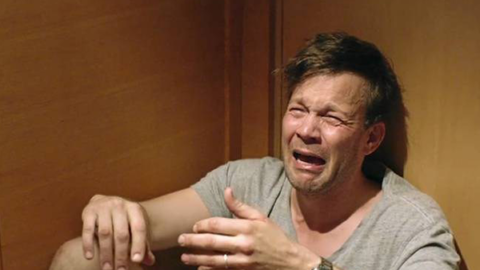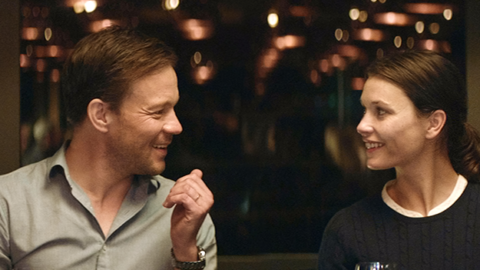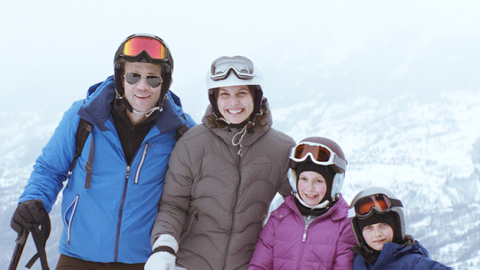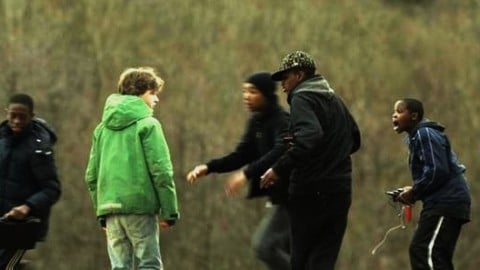Film of the Week: Playground
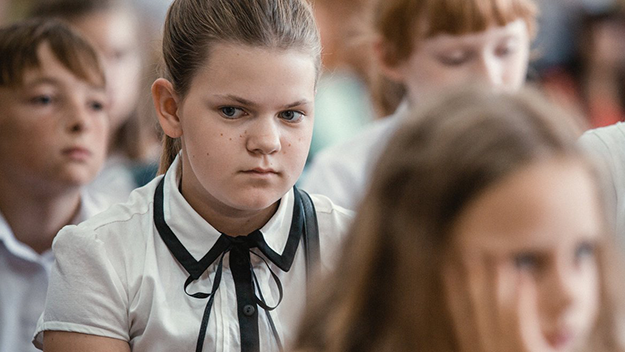
I’ve seen walkouts at festivals before, for all kinds of different reasons—boredom, bemusement, incomprehension—and they’re usually pretty much the same. There’s a gradual trickle of exits, sometimes speeding up as a film goes on, because one departure encourages the waverers until, there being safety in numbers, it’s only the truly courageous, committed, or simply inert who choose to stick around. But I’ve never quite seen a reaction like the one that greeted the Polish film Playground, which showed in competition this week at the San Sebastian Film Festival. A certain scene, at the end of Bartosz M. Kowalski’s drama, caused a sudden horrified mass surge as people leapt from their seats and made for the doors. Later in the same scene—shot in a single extended take—a further intensification of the already horrific action caused a second wave to jump up and go. Plenty of people, however, stayed for what little remained of the film—including a very angry woman who kept shouting “¡Lamentable!” after the lights came up.
It’s understandable that people might want to leave a film rather than sit and feel their sensibilities assaulted: a colleague of mine quite reasonably decided to skip out on most of Gaspar Noé’s Irreversible, feeling that the use of the fire extinguisher in the opening sequence was as much as he needed to see. But I’ve never witnessed such an abrupt collective exit as happened during Playground—and it seemed very much as if this was not just a panicked gut response but, consciously or unconsciously, a mass protest.
At the risk of spoiling the film, should you ever get to see it—and it’s absolutely not a question of spoiling anyone’s pleasure, because Playground is in no way intended to be pleasurable—I’ll explain why. Playground is about children’s cruelty to children, and specifically about the violence witnessed in the long penultimate shot, in which two teenagers batter a young boy to death. Judging from what I’ve gleaned from the film’s Spanish press kit, and comments elsewhere, the story appears to be based on the case of James Bulger, the 2-year-old from Merseyside, England, who was killed by two older boys in February 1993. The facts of the Bulger murder pretty much correspond to what we see in Playground, and Kowalski’s occasional use of CCTV footage seems to underline the allusion. Not only did the Bulger case spark a sort of collective trauma in the UK media and elsewhere, because of its stark exposure of the extremes of juvenile disturbance, but also the revelation that the boy and his killers had been glimpsed on security footage made the UK aware as never before of the ubiquity of video surveillance as a benign or troubling guardian presence.
Kowalski’s film may or may not be directly based on the Bulger story; in his director’s statement, he simply refers to a case he had read about, although the press notes include clippings relating to an episode in Norway and a later case in the UK. Yet it’s hard not to see Playground’s final sequence as specifically relating to Bulger’s death, so closely does it resemble the facts. The rest of the film, however, deals with different material, and one suspects that Kowalski is trying to explain, or at least make us understand, how two young boys—Playground’s killers are at least 12, two years older than the culprits in the Bulger case—could be driven to murder. In my view, it’s not a goal that he persuasively achieves.
The film comes in six numbered, titled sequences. The first, “Gabrysia,” shows a 12-year-old girl (Michalina Swistun) in her parents’ glacially marbled, coldly luxurious upper-middle-class home, getting ready for school and experimentally putting on lipstick with solemn determination. Glaring intently at the camera, Gabrysia has a hard, serious face, and an intensity that initially comes across as menacing; together with her tightly buttoned white school garb, this makes us fear the worst about her nature. But Kowalski is misleading us. Gabrysia isn’t the fascistic bully we might lazily assume on seeing her implacable expression: rather, she turns out to be a victim.
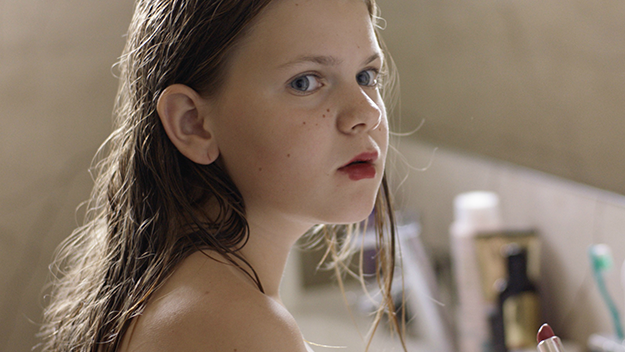
The next section, “Szymek,” introduces us to a boy (Nicolas Przygoda) living on a drab estate, acting as carer to his father, a wheelchair user—and showing him tender, cautious compassion until suddenly, shockingly, he and his dad come to blows. We follow Szymek to school, in a sequence overlapping with the previous episode; everything happens in the course of a single day, the last of the school year. Section three introduces Czarek (Przemek Balinski), a handsome blond lad first seen staring blandly at a crying baby in a cot; we then see him put upon by his mother and older brother. For whatever reason—so much in Playground is left tantalizingly unstated—Czarek shaves his hair off with electric clippers, in a long single take done for real. Kowalski asks a lot of his young nonprofessional actors, and you have to hand it to them—they rise to the occasion intrepidly.
The following section shows the kids at school, and we see what’s been making Gabrysia so tense: she has a crush on Szymek. An older girl gives her a brisk lesson on how to chat up a boy; she’s not Gabrysia’s friend, however, but has been paid for her help. Nothing in these children’s world is done from any innocent altruism, as we see when the older girl tells Szymek that he has no choice but to do what Gabrysia says and meet him after school: if not, she says, “Your naked butt will go online.”
In the next section (“Ruins”), Szymek accordingly shows up for the assignation on a secluded piece of wasteland; Gabrysia has come armed with a condom. But her beloved has Czarek in tow, and the boys abuse and humiliate the girl—with the aid of their camera phones, of course—before seemingly getting bored and leaving. Now the film gets impressionistic, Kowalski dropping the cold, detached observational style largely used till now. Seemingly pumped up on their bullying of Gabrysia, Szymek and Czarek walk cold-eyed in slow motion, like movie gangsters, as various adults stand motionless watching them in impotent horror, seen from the boys’ POV; the sequence’s final shot shows the boys from above, walking through a field of frozen adults, as if the film’s realism has suddenly taken on an edge of nightmare. There’s a decided touch of “living dead” to this sequence, although it’s a moot point who’s dead inside, the boys or the adults around them.
The boys—inevitably, it seems, in a film about troubled youth—then visit a shopping mall, the same one that we’ve glimpsed briefly in CCTV shots at the start. They look at a video-game store, advertising something called Flames of War (there is in fact a board game of that name, but presumably that’s not what’s represented here). The store is closed, so the boys move on; and the film’s most cold-blooded touch, for anyone who knows the Bulger case, is the way that this fifth section abruptly ends with a glimpse of a small boy in a play area. From here on, if you remember the facts, you dread what’s coming.

The action depicted in the final section feels inexorable, and makes for intensely unpleasant watching. The boy, lured away by Szymek and Czarek—although we don’t see how—is seen happily toddling along with them, swinging in the air as he holds their hands. Then, as they walk through the woods, filmed from a distance in wide shot, the child is clearly not so happy. We can barely see his face at this distance, but we can tell that he’s being dragged along forcibly. And we hear him crying, in a very subtly designed sound mix, his voice lost among the ambient sounds of nature and, later, of an ominously approaching train.
The penultimate shot is a slow burner. As the boys stop near a railway line, we see the child struggle to get away, and we hear his whimpers, deep in the mix; the subtlety of the sound design itself makes it all more painful, so acutely unsettling is the distant sound of the boy’s suffering, and the detachment it enforces on us as observers. One boy starts walking around the kid, poking him with a stick—then the full horror of the scene erupts, as they beat him to death at great length, every moment of the atrocity captured in a lengthy take that presumably depends on CGI for its verisimilitude (the end credits list special-effects technicians). The scene made me wince more than any recent screen violence I can remember; it’s not because we see anything in precise detail, since we’re so far off, but we know what’s being done—and worse, we know whom it’s being done to, and by whom. We’re watching something strictly inadmissible: true horror, and horror directly relating to real events. What’s more, we feel we’re captive witnesses watching it all from at a distance, placed in the position of forensic observers of an atrocity we have no power to stop. Unless, that is, we protest by getting up and leaving, refusing to be complicit.
While taking notes on Playground, I scribbled down the names Haneke and Seidl, and then that of Swedish director Ruben Östlund. I thought of Ulrich Seidl because the Gabrysia sequence reminded me of the Austrian filmmaker’s acidic satirical stance in his fictions. In Playground, the cold parental home, and particularly an exterior of this suburban house—its front garden an absurd, fussy little forest of ornamental trees behind iron fencing—here seems to function as a shorthand for the dehumanizing environment that Gabrysia has apparently grown up in. Point made—and none too subtly.
Östlund came to mind because of Playground’s mall sequences, and the use of a detached observational, surveillance-style viewpoint in his 2011 film Play, which follows a case of teenage bullying at almost unbearable length. Perhaps because it feels so derivative of Play—although we can’t know if Kowalski has seen that film—Playground doesn’t, for me, have anything of the same bite. It also lacks precisely what made Östlund’s film so uncomfortable—the fact that we could never entirely be sure whether we were intended to identify with Play’s victims, or its bullies, or whether we could only adopt the position of adult bystanders unable, or unwilling, to intervene. Playground is much more clear-cut: we can only recoil in horror. It asks us to watch, or to shut our eyes; it doesn’t make us ask questions, at least not in the culminating sequence itself.
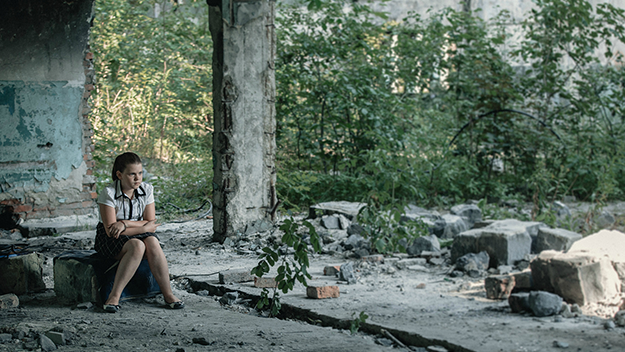
Haneke, finally, comes to mind because, since his 1992 film Benny’s Video—about youth violence and the cauterization of moral awareness that he sees video technology as entailing—the Austrian director’s rigorously frosty stylistic methodology has become the obligatory reference when considering any film that uses clinical detachment to make us look directly at unpalatable content. Haneke arguably took this technique as far as it could go—adding several layers of Brechtian distanciation—in Funny Games (1997), a polemic against the notion of cathartically pleasurable screen violence.
If Playground fails to convince, it’s partly because it largely seems such a textbook emulation of the Haneke approach. The fragmented overlapping episodes and the abrupt cuts, nudging us to make connections between disparate parts, all echo the approach Haneke developed in 71 Fragments for a Chronology of Chance (1994) and Code Unknown (2000). Kowalski’s film, however, is not entirely “objective,” if you can call Haneke’s approach that; at times, he brings something more impressionistic to bear. When the boys terrorise Gabrysia, the handheld camera used throughout the film gets hyper-animated; there are fast cuts, drawing us into the horror of the event, as experienced by the girl, or perhaps the thrill of it, as felt by the boys. In the lead-up to the final killing, Kowalski lays on some ominous atmospheric music, presaging the distant train sounds in the climactic sequence; this feels superfluous and deeply manipulative.
Many of the elements that trouble me about Playground are stylistic: Kowalski shows intense command of his material, but his repertoire of effects feels over-familiar. But what troubles me most about the final scene is the very fact that it’s done with the absolute distanciation we think of as Haneke-esque. We know that Kowalski is not glamorizing, or even dramatizing, which he seems to do in the scene of Gabrysia’s ordeal; in the murder scene, he’s de-dramatizing, simply insisting that we look. Yet this very detachment that in theory should make the final scene so rigorously demystificatory makes it all the more unpalatable: Kowalski shows at a distance, seemingly without dramatic rhetoric, and yet the dramatic rhetoric is there, only subtly hidden. The elegant multi-texturing of the sound mix, giving us the boy’s cries at a distance, makes them all the more distressing. A lot of finely tuned work has been put into the sonic effect that makes us feel: he’s so near, yet so far, and we can do nothing. What starts as rigorous detachment becomes a different sort of cruelty: in a way that’s not intended cynically, but that finally feels cynical, detachment becomes merely an effect, just as the CGI that went into making this scene realistic is a hyper-sophisticated effect, a display of expertise applied to the abject. The detachment ostensibly asks us to bear witness; but what we end up witnessing is only the sophistication of the filmmaking. What Kowalski is displaying, ultimately, is nothing more than his own cold audacity.
There are plenty of troubling issues in Playground that will no doubt fuel further discussions of the film. One is the very fact of asking children or teenagers to enact scenes of extreme violence: you hate to imagine how this drama felt to Kowalski’s young nonprofessional cast, although the end credit for a psychologist suggests the ramifications were thought through very responsibly. There’s also the question of whether it’s appropriate, from the point of view of ethics or just of taste, to depict particular types of horror. While certain themes that are less taboo in cinema than they once were, we still often feel uncomfortable seeing them depicted as drama, even if it’s for our edification and moral sensitization. Whether or not we can always say exactly why, it can feel grossly intrusive or otherwise improper to reconstruct real episodes of sexual violence or of genocide; in the case of depictions of the Holocaust, it takes a pitilessly audacious film such as Son of Saul to rethink the question. As far as reconstructing or evoking an actual child murder goes, Playground does not, I think, have such boldness, just a cold sophistication that finally feels cynical, despite Kowalski’s honorable investigative intentions.

Playground’s coldness made a striking contrast with another detailed depiction of violence in a movie showing at San Sebastián—Chilean film Jesús, by Fernando Guzzoni. In one lengthy scene, a group of teenage boys brutalize a drunken boy in a park at night. The film isn’t nearly as overtly sophisticated as Playground, and its moral perspective is more conventional: punishment at last comes for one of the boys involved. Jesús may be more direct in its commentary on a generation’s vacancy, but the violence involved somehow feels more human, insofar as the energetic handheld style actually takes us into the minds of the aggressors: we actually feel their excitement at what they’re doing, even if we don’t identify with it. Still, it makes us understand their actions, and it’s only afterward that the full horror of what they’ve done fully dawns on us—just as it dawns on the film’s antihero in a bleak comedown. Jesús allows us to understand young male violence; Playground, conversely, coldly presents violence to us in a way that doesn’t get us very far.
The problem is not that Playground doesn’t explain—it’s not obliged to—but that it over-explains, offers too many possible causes for the boys’ violence, most of them of a highly conventional kind. The film offers some determining causes that are timeless constants—parental distance, uncomprehending adult disapproval, poverty, excessive responsibility at a young age—but it also throws in elements that are effectively new, as if in a deliberate updating of the Bulger story. Look what we have to deal with now, it seems to say: increasingly brutal video games, social media, revenge porn, the rise of the profit motive, the oversexualization of children. It’s an excess of rationalization that feels like overkill but that tells us little. In its numb way, Playground finally feels somewhat hysterical: look at the terrible times we’re living in. The film’s final image is a two-shot of the boy murderers sitting side by side, blank-faced, numbed, looking not so much shattered by what they’ve done as just vaguely wiped out. Serious and ambitious though its aspirations are, Playground leaves us feeling much the same—and none the wiser.
Jonathan Romney is a contributing editor to Film Comment and writes its Film of the Week column. He is a member of the London Film Critics Circle.



